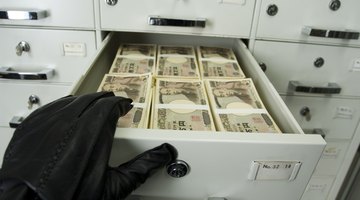How Do Silent Bank Alarms Work?
The scene's familiar from dozens of TV cop shows. A bank robber demands money, the staff cooperate but secretly someone presses a silent alarm. It may be a button under a desk or tripped by the touch of a teller's foot. The police may be the ones who capture the bad guy, but a lot of the credit goes to the security company's tech.

Spreading the Alarm
Triggering a silent alarm breaks a circuit, which shows up on the control panel at the alarm company's office. Distance is no obstacle -- the alarm should register whether the company's across town or 3,000 miles away. Banks can use teller-operated alarms and automatic alarms. In one Chicago robbery, the bandit forced the teller to turn off the bank's regular alarms, then open a safe. That security bypass triggered an automatic silent alarm. The alarm company notified the police, who arrested the thief before he left the bank area.
The Panic Button
Banks can hide a silent-alarm button on the side of a desk, under the teller counter or inside a safe. Some companies offer emergency buttons disguised as a key fob or a pendant. As soon as an employee flips the switch, it triggers the control panel at the alarm company. Some companies let the bank designate special buttons for particular emergencies. One button can be set to tell the company to send for paramedics rather than police, for example.
The Bill in the Trap
It takes a lot of nerve to press an alarm button with a gunman watching. One way to get around the fear is to have the security company install bill traps in the teller drawers. To set the alarm, a teller slides bills between the top and bottom of the trap. If she pulls the bills back out, the parts of the trap touch, triggering a contact, which sends the alarm. The teller doesn't have to do anything but give the robber money to make the trap work.
Silent Drawbacks
One reason police don't respond directly to silent alarms is the risk of false alerts. If a teller jars the notes in a bill trap accidentally, for example, that error may be enough to let the parts of the trap make contact. It's the security company's job to separate false alarms from real ones before notifying the police. This extra step delays the police response to real crimes, though. The Center for Problem-Oriented Policing says on its website that most robbers aren't worried about alarms because they figure they can grab the money and get out fast before the police show up.
References
- U.S. Legal: Silent Alarm System
- Portland Police Bureau: A Guide to Robbery Prevention
- NBC: How Silent Alarms Can Help Bank Robbers
- Chicago Tribune: Bank Heist Done in by Silent Alarm
- AllGuard: Why Panic Alarm Systems for Businesses?
- Honeywell: Panic/Holdup Switch
- Interlogix: Bill Trap
- LeMars Daily Sentinel: Bill in Trap Sets Off Bank's "Silent" Alarm
- Center for Problem-Oriented Policing: Responses to the Problem of Bank Robbery
Writer Bio
A graduate of Oberlin College, Fraser Sherman began writing in 1981. Since then he's researched and written newspaper and magazine stories on city government, court cases, business, real estate and finance, the uses of new technologies and film history. Sherman has worked for more than a decade as a newspaper reporter, and his magazine articles have been published in "Newsweek," "Air & Space," "Backpacker" and "Boys' Life." Sherman is also the author of three film reference books, with a fourth currently under way.
Photo Credits
- whitetag/iStock/Getty Images
- whitetag/iStock/Getty Images
More Articles



